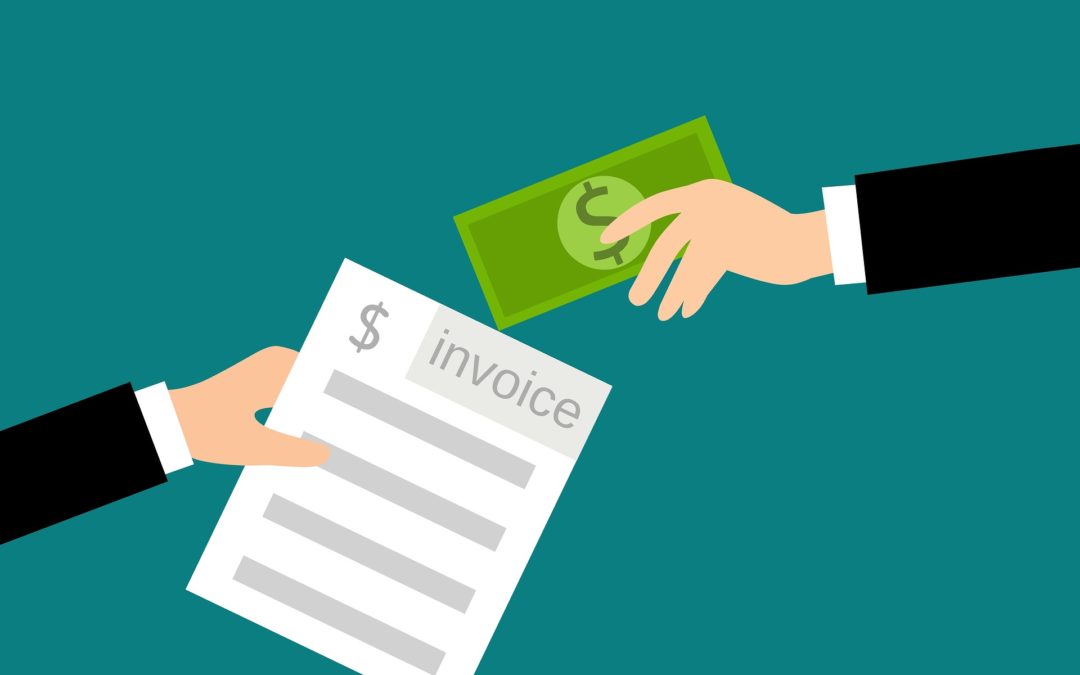If you’re like most business owners, then chances are someone owes you money. In this post, I’m going to show you how to get paid faster and turn those unpaid debts into money in the bank.
In a study by JPMorgan Chase, they show that half of small businesses only have a large enough cash buffer to allow them to stay in business for 27 days, if they stop bringing in money.
So when a customer who owes you money takes longer to pay than they should, they are putting your business and your livelihood at risk.
Unfortunately, this is likely to get worse. Customers are likely to take much longer to pay their bills as the economic impacts of Covid-19 start to bite. In a survey by Gartner, (a research firm), of small organisation Chief Financial Officers (CFO’s) – 54% of them say that they plan to slow pay vendors [that’s you!] to cope with COVID-19 Impacts
The good news is, if you apply these tips then you’re going to get paid faster!
Introduction
First thing first. A lot of business owners offer credit to their customers. Which in accounting speak is called Trade Debtors, or debtors for short.
If you use an accounting software package you can find out the money you’re owed by your debtors fairly easy by looking at your unpaid invoices – but if you don’t invoice regularly, use a spreadsheet or a shoe box, then things will be a little trickier.
Either way, you’ll need to know what the value of these trade debtors/unpaid invoices is.
Go and do that now. I’ll wait.
Data insights supplied by accounting firm Xero show that only half of businesses are cash flow positive at the end of each month (i.e bringing in more cash than they spend).
Which means that half of all business are using some form of debt (whether that’s the money you’ve put into the business or you’ve borrowed it from the bank) to survive.
It costs a lot to offer credit
Assuming you’re in the 50% of businesses that aren’t cash flow positive at then end of the month, then chances are you’re using a bank loan or overdraft.
So, if you average $100k of unpaid invoices at the end of each month, then over the course of a year, that’s going to have cost you about $10k in interest. That assumes of course that you collect all the invoices you’re owed and have no bad debts (where people don’t pay you).
Now just say you’re making a 5% net margin after all your expenses. To cover that $10k of interest, you’ll need to have made $200k sales (and collected it) – just to cover the interest payment on the money you borrow to offer credit!
Let that sink in for a moment, $200k of sales – just to pay the interest.
Even though interest rates are at historic lows, borrowing money can be still be expensive. And that assumes the banks will lend it to you. Which is why many businesses use suppliers as a source of free cash borrowing by delaying payment.
You are a free source of funding to your customers
In the same way it costs you to borrow the money you use in your business, customers save the equivalent of thousands of dollars in interest payments themselves, just by delaying the payment to you.
Assuming your customer had the same costs of borrowing as you, for every week they delay paying what they owe, they are saving $200 a week.
So to lower your costs, boost your income and have more money in the bank, you’ll want to get paid faster, which means you need to be far more proactive in collecting the cash you’re owed.
Quickly collecting the cash owed to you will dramatically increase your chances of business survival.
FREE DOWNLOAD ‘GET PAID FASTER CHECKLIST AND EMAIL TEMPLATES’
1. Do you need to offer credit?
The first thing you want to think about is whether you need to actually offer credit to your customers in the first place, If it’s generally accepted in your industry that credit is offered to customers, then of course you will need to offer the same. But before jumping in with credit. Think about the alternatives you can offer instead. Could you perhaps accept credit card payments instead or is it possible for you to charge up front and get paid in advance?
Just remember, it’s your business, your rules. In Fact by offering credit, it means the more cash on hand you need to have.
2. Make your payment terms clear up front
Be really clear up front about what you’re going to deliver and what your payment terms are so that there’s no doubt what the expectations are for payment. The best way to do this is in the form of a written contract and get your client to sign it – you can make it really easy for yourself and automate the process using software such as Docusign.
Just so that you are really clear what payment terms mean check out my post payment terms explained.
3. Understand your customers payment processes
When you’re dealing with bigger businesses, they’ll have a robust process in place for paying invoices. If you don’t understand that process then you’ll be waiting an unnecessary amount of time to get paid.
For example, one of the most common mistakes I’ve seen is suppliers sending the invoice to the person that they did the work for. Sounds logical right, but chances are they don’t know what to do with the invoice either.
I recall with one client I worked with, a manager had a folder full of invoices in his drawer he didn’t know what to do with. So they just sat there, along with the reminders.
So make sure you understand who the invoice needs to be sent to and the postal or email address where the invoice is to be sent.
Also make sure that you ask for a purchase order number and don’t do any work until you get it.
Many owners of small businesses are so excited to get the order from the big firm that they get to work straight away and deliver the work in the expectation that either they don’t need a purchase order or that one will be along in a day or two.
Believe me purchase orders can take weeks to produce, which involves setting you up as a supplier if you aren’t already an established supplier and often the person ordering from you, hasn’t raised a purchase order before or it’s such a long time since they’ve raised one, they’ve forgotten how to do it.
Purchase orders
Then of course, the purchase order will need approval and again that can take weeks to obtain too.
So in the unlikely event that your customer says a purchase order isn’t required. Ask them to put the order into writing (or email) and send it to you along with where to send the invoice to.
A purchase order is what many businesses use to ensure that an order is properly authorised – and so can be paid. Rather than approving expenditure afterwards, when it’s too late to do anything about it.
A purchase order is the official confirmation from the buyer of an order. A purchase order details the quantity of products or services to be supplied along with the unit price.
A purchase order has a unique number which is tracked through the businesses finance system and confirms the quantity ordered, the price agreed and things like the delivery date.
Once you’ve accepted the purchaser order it’s a legally binding agreement.
If you charge delivery or shipping costs, then make sure that those costs are stated on the purchase order in to avoid any delays in payment.
Because a purchase order is used to match to an invoice. If the purchase order matches the quantity supplied and the price per item, then the invoice gets paid.
If it doesn’t – for example there’s a difference between the number supplied and the number invoiced, then guess what?
The invoice doesn’t get paid!
I’ve seen many invoices not get “matched” because a supplier charged shipping separately and it was never quoted on the purchase order so guess what….
The invoice doesn’t get paid!
And you might be surprised to learn that your customer won’t tell you that the purchase order doesn’t match and isn’t cleared for payment.
4. Invoice straight away
Invoicing right away is a surprisingly simple (and effective!) way to get paid faster, but bizarrely, it’s one area most people don’t do. Let me give you an example. We had a leak at home and had to call out a plumber.
The plumber came and sorted out the leak pretty quickly, which saved us a whole load of hassle mopping up and dealing with water damaged items.
Now I know from past experience dealing with this plumber is he operates 7 day payment terms.
A week and half after he came out and sorted the leak I got the invoice with a payment day 7 days further on.
So even though I will have paid the invoice in line with the payment dates, he would halve got paid a week or so earlier if he invoiced the day the work was done.
A friend of mine had an electrician installed some lights at his home, but the electrician didn’t issue an invoice. Even after my friend reminded him a month or so later as he wanted to pay him, no invoice ever arrived.
So if you want to get paid, make sure you issue an invoice.
5. Include your bank details on your invoice
Remember those things called cheques? Bits of paper in a book which was essentially an instruction to the bank to pay for the goods or services they had received. Well apart from a few people over 70, guess what, no one uses them anymore.
Funny story – I went to our local bowling club (cheap food and drinks!) and the person in front of me was paying by cheque. The cashier literally had no idea how to process it and had to ask for help from a colleague.
Most of the modern world nowadays instead of using cheques make an electronic payment via the banking app on their smart phones while they are drinking their latte at Starbucks.
But it’s a little difficult to make a payment when the customer doesn’t include their bank details and has to contact you for them – which they might not do as they don’t get round to it and cause a further delay in your payment if your don’t use put those payment details on your invoices.
6. Include the Purchase Order Number
As I said in tip number 3 – it’s really important that you know, follow and understand the payment process of your customer in order to ensure that you’re paid on time.
Putting the purchase order number of the on your invoice is a key step to making sure you get paid on time.
This is because it allows the person clearing the invoices, to easily match your invoice to what was ordered. Where business receive a lot of invoices, chances are that the invoices will be scanned or received electronically and the software will hunt down the purchase order.
If the system can’t find find it, it becomes an unmatched invoice. This means that some poor Accounts Payable person has the fun task of working out who they owe money too. And because the firm uses software to process the vast majority of invoices, it doesn’t mean that there’s a lot of people left to sort out your payment. Which means the Accounts Payable person, will get to your invoice, when they get to it. Which could be no time soon.
I have worked with some organisations, who simply return any invoice not quoting the purchase order number back to the supplier. At least this way you know their’s a problem, but other organisations just sit on the invoice and wait until you follow up.
7. Check everything is ok
About a week before your invoice is due, check in with the person who you did the work for. You can do this, by sending them an email and asking them if everything is ok with the work that you did for them and if they need anything else from you. This has three advantages;
1) Provides in writing that the work is acceptable – which you might need later if they don’t pay and you can use it as evidence.
2) asking if there’s anything else you can do, might generate some extra sales!
3) shows a great level of customer care.
You can then follow up a day or two before the invoice is due that the invoice will be paid on the due date.
8. Follow up
Some businesses simply don’t pay until you start chasing the payment. I’ve seen suppliers go unpaid simply because they haven’t followed up on the invoice.
It might sound odd, but think about it if you owe 50 suppliers money – which one do you pay first? That’s right the one who calls you every day asking where their money is.
A lot of business owners worry about asking for the money for fear of upsetting the relationship with the customer. But if they customer’s not paying you, how does your customer view the relationship with you?
Just remember, you don’t have to be all heavy handed when you ask for the money, just be polite!
9. Stop work or supplies
Now as I’ve already said, many businesses will be using your money to finance their businesses. So, if you’re supplying goods or services, and they don’t pay you until they get paid, then if they don’t get paid, then you won’t either.
Of course, if a customer isn’t paying you until they’ve been paid, then you might not realise it, but you’re taking on the extra risk of your customer not getting paid.
When you’re in this situation, it’s tempting to keep on supplying customers in the hope that they will soon be paid. And once they get paid, you’ll get paid. The problem is, that the longer you continue to supply without getting paid, it simply means more risk. You are essentially taking on the risk of your customers’ customer not paying them. Which isn’t great for you, or wallet.
So if the customer hasn’t paid by the invoice due date, politely decline to do more work for them until they’ve paid you what you’re owed.
A lot of business owners worry that they’ll upset the customer and they’ll loose their business. But if your customer isn’t paying you, then they are hardly a great customer in the first place are they?
Just remember, it’s perfectly ok to fire your customers if they don’t support the aims and objectives of your business.
10. Agree a payment plan
During lockdown, I received a bill from a lawyer for some work they’d done for us. With the email that accompanied the invoice, there was a little message which simply said:
“if you can’t afford to pay all this invoice at once, please let us know immediately so we can agree a payment plan.”
I thought this was a really proactive way of getting some money in. Much better than waiting a month to find out you haven’t been paid and having to constantly be chasing it.
If you’ve got customers who owe you money for more than 90 days try this:
- Contact your customer now and instead of asking them for the full amount now, ask them how much they can afford to pay each week.
- Start small by saying; “could you afford $10 a week?”;
- and if they say yes, say “could you afford $100?”;
- If they say yes, try: “could you afford a $1000?” – and if they say no, “then how about $500?”
I know one business owner who tried this exact strategy;
He had been waiting months to get paid. By settling on $500 a week, he collected the $25k he was owed in full, over the course of the following 12 months.
The supplier managed this by working with his customer to settle on a manageable amount. This allowed a debt to be cleared that had been hanging about for months. In this case, the customer wasn’t disputing payment, he just didn’t have the money to pay.
By being flexible you’re avoiding not getting paid at all, and and at the same time, building some valuable goodwill with the customer.
Often times when people don’t know what to do, they do nothing.
They hope that a solution will come their way. Unfortunately, a solution rarely falls from the sky, no matter how long you wait for it!
Which of course means, that if you’re owed money and you don’t actually do something about it, you might get very old waiting for it to be paid.
Next steps
Please let us know either on Twitter or Facebook which tips you like and which tips you’ve tried. What were the results? Do you have any tips to add?
DOWNLOAD FREE ‘GET PAID FASTER CHECKLIST AND EMAIL TEMPLATES’



